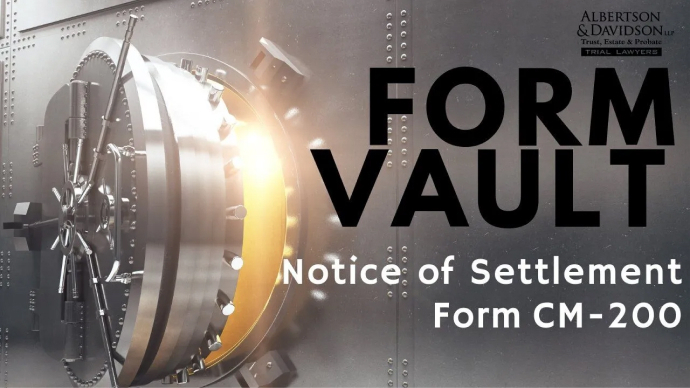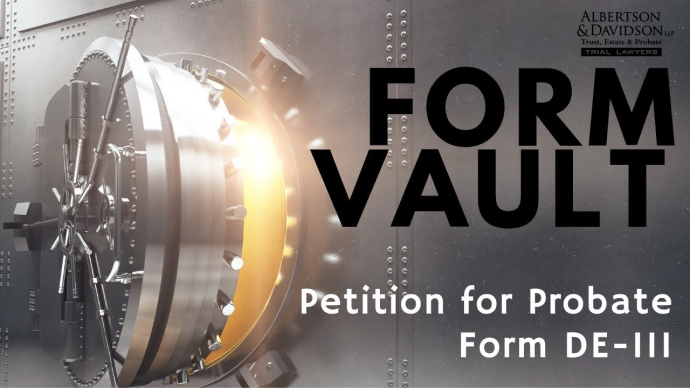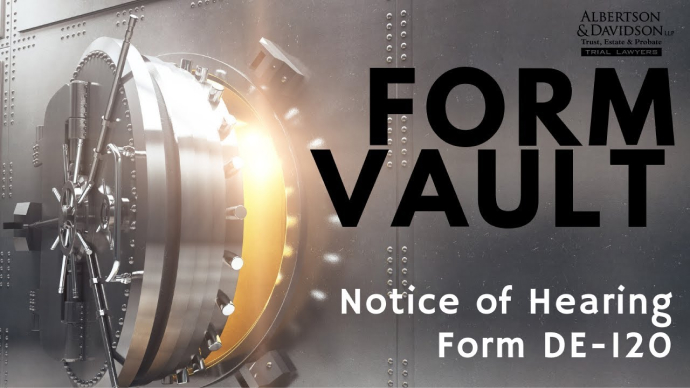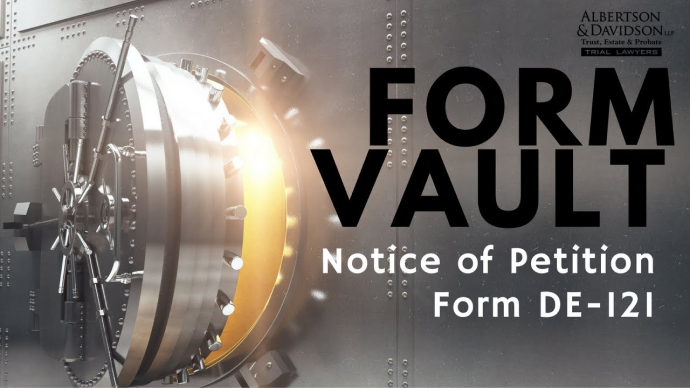Video Transcript
The following is an unedited, verbatim transcript of our video. It is not intended to be a stand-alone article.
Hi, this is Keith Davidson at Albertson & Davidson. Today, I’m going over the Notice of Settlement. It’s a form that you can use to notify the court that your matter has settled, and these are important forms because there’s a lot of things that the court is doing with your case behind the scenes that you may not realize especially as different hearings approach. There’s a whole process that the court goes through to prepare that case for a hearing. And so, when you settle your case, it’s very helpful for the court to know that the case has been settled, so that they don’t have to expend their resources trying to prepare your case for a hearing and plus it notifies the judge of the status of your case.
CM-200
So let’s walk through the form and we’ll take a look, we’re going to start at the California Judicial Council forms, as we always do, just right there on Google, and this is one of the case management forms. So you just go to the case management section, and there’s not too many of the forms under this tab, but the form we’re going to be using is CM 200, the Notice of Settlement of entire case. So this is the form, it’s actually quite simple, but again, it’s very important for the court. So you’re going to start off by just putting your name or your attorney, we’ll put his or her name at the top here. And then you’re going to want to fill out your firm information and address and all that good stuff, you want to make sure you put your phone number, your email address so the court can notify you, and you have to say who you’re an attorney for, so we’ll use the fictional name of Nancy Smith. And then you have to fill in the county that you’re in, so whatever county you’re practicing in – Los Angeles, San Diego, Orange County, San Mateo, San Francisco, and on and on. And make sure that you put the street address, the mailing address, if it’s different from the street address especially, the city, zip, and the branch name. All of that you can find on the court’s website. And then you have to put the name of the petitioner or plaintiff. So we’ll use our fictional client and we’ll say that the respondent was Robert Johnson. In that way, the court knows what case this is for. We also would insert the case number over here so that we could file it in that case number. And we want to reference the name of our judge and our department right on these two lines.
Unconditional or Conditional Settlement
So this is not a dismissal of your case, what this is is a step that you’re going to take after your case settles before you ask for dismissal. And again, it’s just to notify the court that the matter has settled. So you have two options, you could have an unconditional settlement, meaning that the matter is settled, everything’s done and you don’t have to wait any longer, in which case, a request for dismissal will be filed within 45 days after the day of the settlement, and then you have to put the date of the settlement. So if we say the date of the settlement was December 1st 2018, then 45 days after that, January 15th or there about you have to file an actual dismissal of the lawsuit. If however, there’s conditions in the settlement, then you’ll click this box “conditional.” And then the court wants to know a request for dismissal will be filed no later than what date, so let’s say you have to wait 90 days for payment, and then after that time you’ll have 45 days because once the settlement is done, you’ll have 45 days to dismiss the matter. So you have to inform the court of that. The court wants to know the date the initial pleading was filed. So if you filed your lawsuit on March 1st – let’s say 2018, then you’d fill that in here. And then the next scheduled hearing or appearance, so there might be a status conference, maybe there’s a trial setting conference, whatever it is, you put the next hearing. And then you have to put in the date, the time, and the department. And again, that’s so that the court knows that this matter has settled, and that they don’t have to go through the work of trying to prepare for that hearing. The same thing applies to the trial date, so if you have a trial date in your case, the court wants to know what was the date set for trial and the time and the department. If you have no trial set, then you can just click that box, again, the court needs to know are those dates freed up because you’ve settled your case, does the court need to prepare for a trial on their side, whatever it is that is the case, just fill that out there. And then down here, you’re going to fill it out if you’re an attorney, you can just type in your own name and you just check the box “attorney.” If you’re a party without an attorney, you check that box, real easy, you sign it.
Proof of Service
And then down here we have our proof of service. So this is where you want to serve this form on all the other parties by first-class mail. And so you’ll just fill out the information, we’ve covered a number of different proofs of service in our form vault series and you can just go through it. You have to list the name and address of everybody. You can also attach an attachment which is what I always like to do, and if you’re going to do an attachment, I like to type up here “see attachment” so that there’s no confusion as to why this is blank. You don’t want the court thinking that you just filed a blank notice of proof of service, you want to be able to say that there was an attachment. So, once you have everybody listed on here that you’re going to serve, you’re going to mail them a copy of this. The person who serves this form is going to sign it at the bottom here. And then, this entire form is going to be filed with the court in your case number. Once you do that, then the court will be notified that the matter is settled, they’re going to thank you because they don’t have to prepare for hearings or trial that now aren’t going forward because your matter is settled, and it’ll put everybody on notice, that the matter is done, and the next step, in the final step, will be filing your dismissals.




